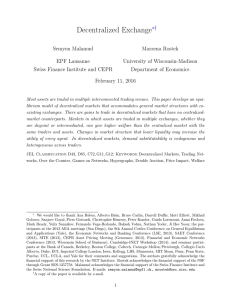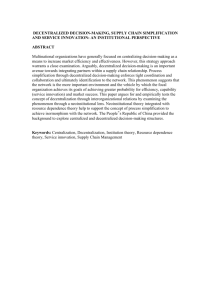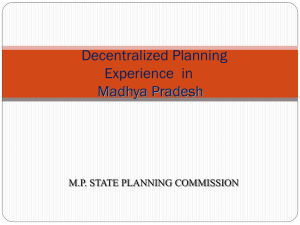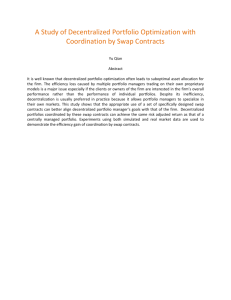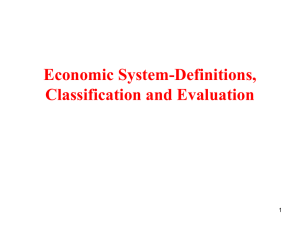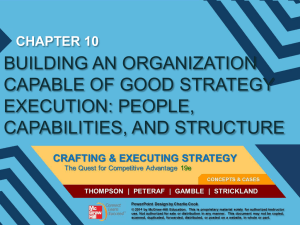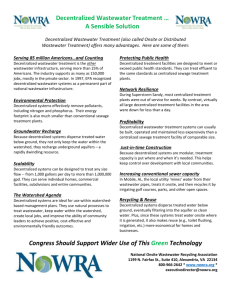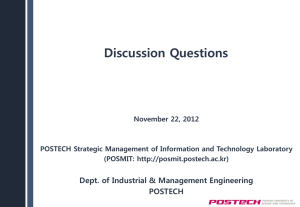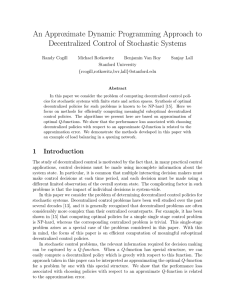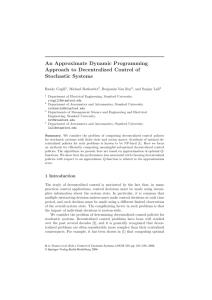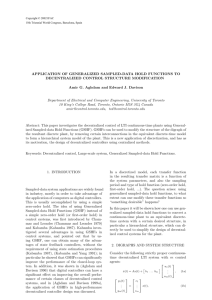An Approach to Compliance in a Decentralized Environment
advertisement
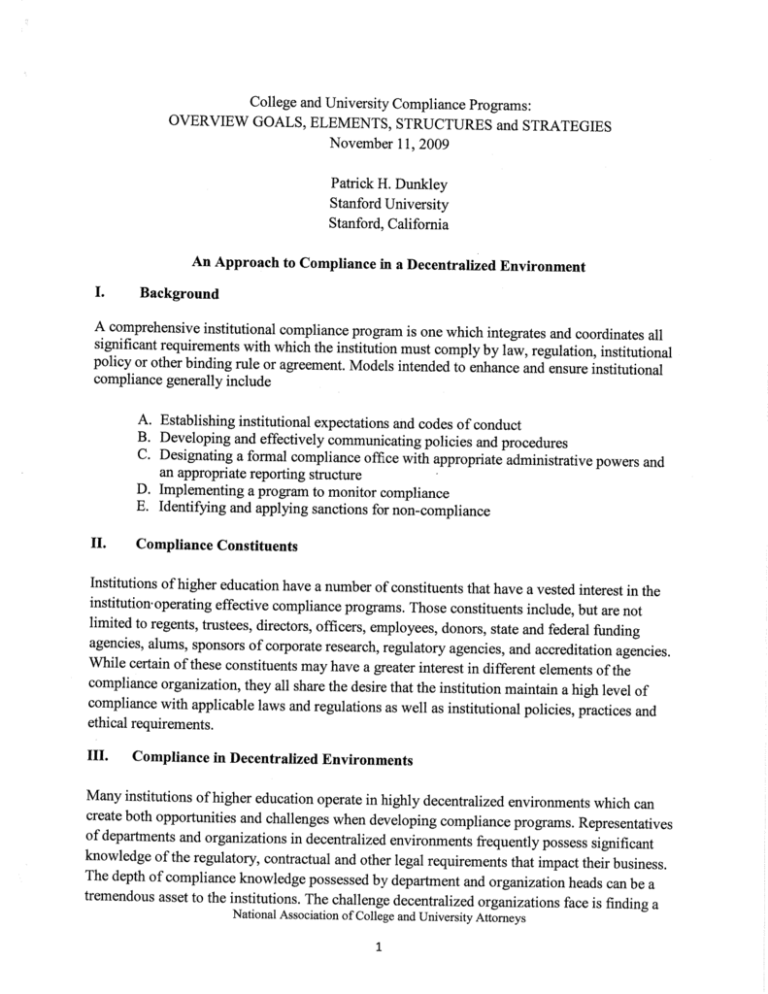
College and University Compliance programs: OVERVIEW GOALS, ELEMENTS, STRUCTURES and STRATEGIES November I1,2009 Patrick H. Dunkley Stanford University Stanford, California An Approach to Compliance in a Decentralized Environment I. Background A comprehensive institutional compliance program is one which integrates and coordinates all significant requirements with which the institution must comply by lJw, regulation, institutional policy or other binding rule or agreement. Models intended to enhance and ensure institutional compliance generally include A. Establishing institutional expectations and codes of conduct B. Developing and effectively communicating policies and procedures C, Designating a formal compliance office with appropriate administrative powers and an appropriate reporting structure D. Implementing a program to monitor compliance E. Identifying and applying sanctions for noì-compliance II. Compliance Constituents Institutions of higher education have a number of constituents that have a vested interest in the institution'operating effective compliance programs. Those constituents include, but are not limited to regents, trustees, directors, officers, employees, donors, state and federal funding agencies, alums, sponsors of corporate research, regulatory agencies, and accreditation agencies. While certain of these constituents may have a greater interest in different elements of the compliance organization, they all share the desire that the institution maintain a high level of compliance with applicable laws and regulations as well as institutional policies, practices and ethical requirements. ilI. Compliance in Decentralized Environments Many institutions of higher education operate in highly decentralized environments which can create both opportunities and challenges when developing compliance programs. Representatives of departments and organizations in decentralized,environments frequently possess significant knowledge of the regulatory, contractual and other legal requirements that impact their business. The depth of compliance knowledge possessed by department and organization heads can be a tremendous asset to the institutions. The challenge decentralized organizations face is finding National Association of College and University Attorneys a way to leverage the knowledge possessed by the departments and disseminate that knowledge to the remainder of the institution. It can be helpful for decentralized organízations to develop a "matrix" compliance program. A matrix framework enhances compliance primarily through the actions of a decentralized matrix of institutional offices and officers, coordinated and assisted by a small central compliance function with a reporting relationship to the institution's governing board. The matrix program connects the individual components, coordinates their operations, and represents the institutional perspective, but at the same time does not involve the creation of a large centralized compliance organization. IV. Typical Compliance Matrix Areas Broad compliance areas can vary from institution to institution, but generally include o Americans with Disabilities Act o Campus Crime Statistics o Conflicts of Interest o Donor Gift Restrictions o EEOC/Affirmative Action . Environmental Health and Safety ¡ Export Control o Financial Aid o Fire and Building Safety o Global Operations o Hospitals . Human/Animal Subjects o Human Resources o Immigration . Land Use and Investment Property o \Çfu\ o Privacy - Student and Other Records o Procurement o Property Management ¡ Research Administration o Research PolicY o Scientific Misconduct o Securities Exchange o Sexual Hrassment . Taxes o Technology Licensing/Intellectual Property o Workers Compensation In a decentralized environment some compliance matrix areas such as Americans with Disabilities Act, sexual harassment and conflicts of interest cut across all departments and disciplines and, therefore, have clear and direct universal applicability. For these areas, basic knowledge is important for all parts of the organization. Other compliance areas such as NCAA, campus crime statistics and human and animal subjects have more discrete direct applicability for only a select few departments or perhaps a single department. Still, a third category of "stealth" compliance risks exists. These stealth risks include areas such as private use of tax exempt bond financed facilities. Although compliance in these areas has universal applicability, the requisite knowledge often resides in one department (e.g., tax). Nonetheless, it is vital that all parts of the organization have sufficient knowledge to identiff issues that, if not identified, could result in significant liability and reputational harm to the institution. National Association of College and University Attorneys V. When a Decentralized Approach Can be Considered Not every decentralized environment is an appropriate candidate for a decentr alized.approach to institutional compliance. If an organization does not have a strong compliance-oriented culture and extremely knowledgeable management in its administrative departments, a decentralized approach may create unacceptable risks. VI. Steps to Developing a Compliance process A. The key steps in developing a compliance 1' process include Designating a university official with ultimate responsibility for coordinating the compliance effort 2. Identifying key compliance areas for the institution 3. Designating a university official with responsibility 4' 5. 6. B. and accountability for each compliance area Developing a method of disseminating compliance information across disciplines Developing a method of identifuing risk areas Providing legal and other support to each compliance area to ensure the necessary resources are available to understand the law and monitor changes in the law The key elements of an effective decentralized compliance process include 1. 2. 3. Written code of ethics and conduct Explicitly stated compliance policies and standards Training for all employees on code of ethics and compliance policies and standards 4' Training for affected employees on laws and regaulations related to their jobs 5. Adoption of adequate procedures, resources and systems to permit compliance 6. Maintenance of a process to allow anonymous reporting of alleged noncompliance 7. Protection for employees who lodge reports 8. Regular monitoring and auditing process to test compliance 9. A mechanism to enforce rules and discipline rule violators 10' Mangement commitment to take corrective actions and follow-up to ensure effectiveness of corrective actions 11. Establishment of Institutional Compliance Coordinating Committee, staffed by the Director of Institutional compliance and comprised of the persons functionally responsible for compliance in the designated "matrix" areas along with representatives of the office of the General counsel, office of Risk Management and representatives of the administrative deans of each school National Association of College and University Attorneys 12. Adequate board level oversight of compliance function C. D. Establish Reporting Relationship and Role of the Director of Institutional Compliance 1. Reportingrelationship a". Reports to an administrative officer (e.g., the president or the chief financial officer) b. Direct reporting relationship to a committee of the governing board (e.g., audit committee) 2. Role a. Promote compliance awareness through "ethics initiatives," either institutionwide, or in concert with the faculty and staff training programs of the offices in the compliance "matrix." b. Provide liaison with the Office of the General Counsel, University Communications/Public Relations, and other responsible offices in addressing incidents of alleged noncompliance that arise. c. Work through the Internal Audit function to both monitor compliance and assess the adequacy of compliance activities in each area of the matrix. Include such information in the annual compliance report. d. Implement and publicize a"Compliance Helpline" program, which employees or third parties who have concerns of any kind stemming from possible noncompliance can call to register their concerns, anonymously if desired. e. Develop a formal policy and procedures to protect institutional employees who make allegations of noncompliance. f. Consider needed additions to the compliance matrix (if other important areas of compliance are identified), and keep the matrix up-to-date as the institution's organization changes and new individuals assume roles of responsibility. Establish Institutional Compliance Coordinating Committee The primary pulpose of such a committee is to disseminate information about compliance updates and activities in the matrix and other compliance areas and to consult with and keep the policy makers in the matrix areas updated on any changes in laws or regulations. The committee can be comprised of representatives from each of the matrix areas as well as representatives of the Offrce of the General Counsel and Risk Management. In addition to updates on new compliance, include periodic oorefreshers" on areas of relevant interest. National Association of College and University Attorneys 4
